#crocodylus porosus
Text
Another reason to avoid the water in Australia, or another reason to always carry a pool cue Down Under.
#australia#video short#video#animals#croc#crocodile#salty croc#reptiles#saltwater crocodile#crocodylus porosus
140 notes
·
View notes
Text
Singing Duet

Estuarine crocodiles releasing heat in the local zoo.Photo credit: Jonathan Chua.
The crocodile tank in the local zoo is about the only place here where one could photograph the creatures at water level and it was my favourite.
This image had needed only a stop of negative exposure compensation to isolate the crocs from its background foliage.
#photographers on tumblr#Crocodylus porosus#estuarine crocodile photos#flora fauna#lumix photography#panasonic lumix 100-300mm#panasonic lumix gx1#photography tips#wildlife photography#wildlife pics
2 notes
·
View notes
Photo

こんな写真が撮れるなんて
@ニフレル

ありがとねぇ…!!!!!!!!!
17 notes
·
View notes
Text
Saltwater Crocodile
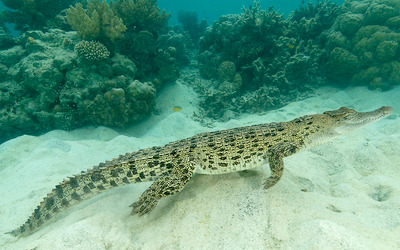
Crocodylus porosus

🔔 The primary behavior to distinguish the saltwater crocodile from other crocodiles is its tendency to occupy salt water. Though other crocodiles also have salt glands that enable them to survive in saltwater, a trait that alligators do not possess, most other species do not venture out to sea except during extreme conditions.
3 notes
·
View notes
Text
World Tomistoma Day 2023
Although I find the concept of a "World Day of" generally stupid, I believe that on the matter of endangered species, it can be a very meaningful speaker.
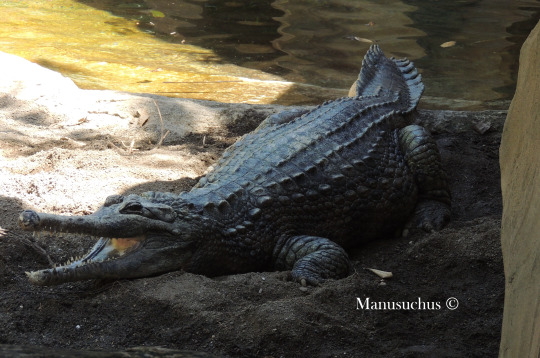
Tomsen, a female T. schlegelii at BioParc Fuengirola (Spain)
Today, August 5th, an initiative of the Crocodile Specialist Group (CSG) together with the "Tomistoma Task Force" is trying to draw attention to this poorly known and misunderstood species.
For those of you who don't know this animal, Tomistoma schlegelii, commonly known as Malayan false gharial is a longirostrine crocodilian that inhabits forested freshwater lakes, slow-moving rivers and swamps of Peninsular Malaysia, Borneo, Sumatra and possibly Java, feeding on diverse prey (From invertebrates to monkeys, small deer, birds and reptiles, with fish constituting the bulk of its diet), and although it is not a particularly aggressive species, there are several records of attacks on humans, with at least one fatal confirmed.
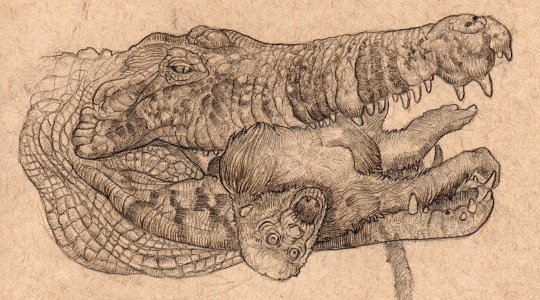
Tomistoma schlegelii devouring a female proboscis monkey (Nasalis larvatus). Inspired by Galdikas et al. 1985 (Illustration made in 2022)
It is characterized by a long narrow snout which blends gradually with the base of the head/skull. Two rows of very small, barely distinct post-occipital scutes. Nuchal scales continuous with dorsal scutes and are almost indistinguishable. They are generally brown in color, with dark bands, including blotches and bands on snout and jaws.
But what makes this species really interesting are two particularities : Its enormous size and its ínteresting taxonomic affinities:
a) Size: It is not uncommon for Tomistoma males to reach lengths of 4 m today, but skeletal remains (Mainly skulls) indicate that we could be (Although improbably) in the presence of one of the candidates for the largest crocodylian species in the world .
In their 2008 study, R. & N. Whitaker noted that the longest skulls in the world belonged to Tomistoma (One at Munich Museum at 81.5 cm; another at the AMNH at 76.5 cm ...) with the British Museum specimen taking the lead with an incredible 84 cm (Leaving all other species behind).
However, observations made on Tomistomas in captivity at the Samut Prakarn Crocodile Farm (Bangkok) and on some wild specimens, determined that the HL:TL ratio was 1:6.4 for the species; and therefore, the British Museum specimen would have measured about 5.38 m in life, certainly a giant but far from the monstrous sizes of some salties (Crocodylus porosus).

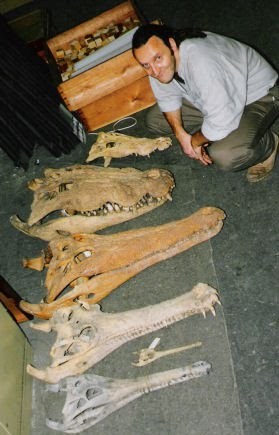
The British Museum specimen. George Craig © (In the second photo, you can compare the size with C. porosus and G. gangeticus large specimens)
b) Uncertain affinities: Tomistoma is the last survivor of an old lineage that originated about 40-50 mya ago. This has made many authors wonder: where does this species fit in the evolutionary tree of crocodylia? And well... it's complicated.
T. schlegelii has long been considered to be a member of the Crocodylidae ( Brochu 2003). Much of the analysis has focussed on skeletal attributes, often constrained that way to allow comparison with fossil material, but there is supporting evidence from soft anatomy as well (Frey et al. (1989) , Endo et al.(2002)...)
But now begins the tricky part : Molecular analyses place Tomistoma as a Gavialid.
( White and Densmore 2001; Janke et al. 2005;McAliley et al. 2006, Roos et al. 2007; Man et al. 2011...) Although some of these studies have been criticized for their methodology, it is clear that it cannot be ignored that they all reach the same conclusion.
Likewise, there are important discrepancies about the times and periods in which both families appear/diverge, so the debate is not yet definitely closed.
Tomistoma are considered vulnerable by the IUCN Red List, nonetheless, it remains possible that T. schlegelii may qualify as Endangered in the future due to ongoing habitat loss and degradation, particularly Malaysia, so this day is still important to spread the word about the species.
I have only been able to enjoy these animals live once, at the BioParc in Fuengirola, Málaga (Spain) where they keep a trio of three adult specimens: Two females (Montse and Tomsen) and a huge male (René, affectionately nicknamed "Pinocho"). This Zoo is the only one in Spain that houses Tomistomas and has achieved the titanic task of their reproduction in captivity.
René, the huge male at BioParc Fuengirola. Video by me.
#zoology#animals#reptiles#crocodiles#nature#crocodilians#wildlife#science#conservation#endangered species#endangered animals
114 notes
·
View notes
Text
Uncharismatic Fact of the Day
It’s a good thing the tooth fairy doesn’t visit crocodiles-- if she did, she’d certainly go broke. Crocodiles have between 60-110 teeth at any time, and each time they lose a tooth they’re able to replace it. Over their lifetime, a crocodile can go through 4,000 teeth.

(Image: A saltwater crocodile (Crocodylus porosus) showing off its pearly whites by Sarah McPherson)
If you like what I do, consider leaving a tip or buying me a kofi!
#saltwater crocodile#Crocodilia#Crocodylidae#true crocodiles#crocodiles#reptiles#uncharismatic facts
101 notes
·
View notes
Text








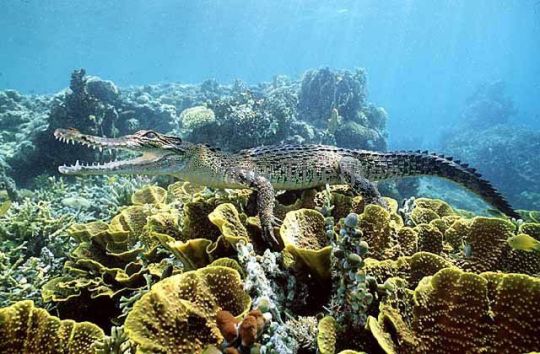
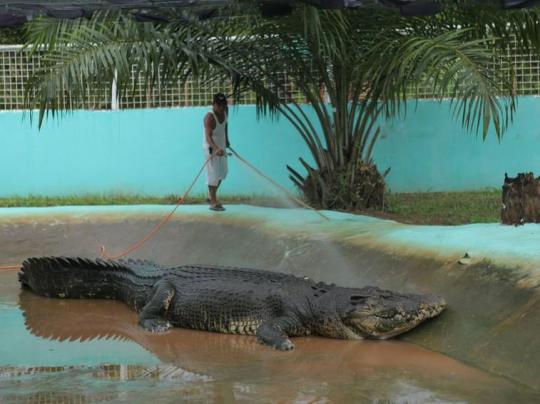
The saltwater crocodile (Crocodylus porosus) also known as the estuarine crocodile, Indo-Pacific crocodile, marine crocodile, sea crocodile, or saltie, is a large species of crocodilian which has a wide range being found throughout India, Southeast Asia, Australia, and Micronesia. Here they inhabit coastal lagoons, wetlands, deltas, estuaries, mangrove swamps, rivers, and freshwater lakes. These moderately social yet extremely aggressive crocodilians feed on a wide variety of prey including invertebrates, fish, amphibians, snakes, reptiles, birds, and various mammals from as small as bats to as large as gaur. Saltwater crocodiles exhibit a great degree of sexual dimphorism with males often reaching 4 to 5 times the size of females. They are also on average the largest extant crocodilian with the biggest males reaching 18 to 23ft (5.5 to 7m) in length and 2,000 to 3,300lbs (900 to 1,500kgs) in weight. In comparison female saltwater crocodiles get to around 8 to 14ft (2.5 to 4.3m) in length and 165 to 1,000lbs (75 to 455kg) in weight. Both sexes have a broader snout and body compared to other crocodile species with a pair of ridges that run from the eyes along to the center of the snout. There coloration is generally a tan to greenish grey in color; but there is variation in color among different populations with some appearing a yellowish tint and others almost black. Like the american crocodile, saltwater crocodiles sport salt glands on their heads that can secrete excess salt, allowing them to drink salt water. Saltwater crocodiles have the highest bite force of any animal recorded at 16,414 newtons (3,690 pounds-force). Breeding occurs during the wet season, during such time a male saltwater crocodile will approach a female in his territory - if she lets him get near, the two will court by rubbing their heads together before mating underwater. The pregnant female will carry her eggs with her for 1 to 2 months before building a nest on the edge of a tidal river or lagoon, laying the clutch inside. She will guard them fiercely for 80 to 98 days, at which point the young crocodiles will hatch and be cared for for the first 8 months of their lives. It's at this point they become large enough to become independent, fending for themselves now they are no longer vulnerable. Females reach sexual maturity at 12 years old, and males at 16. Under ideal conditions a saltwater crocodile may live upwards of 70 years.
#pleistocene#pleistocene pride#pliestocene pride#pliestocene#cenozoic#crocodile#saltwater crocodile#marine life#ocean#saltie#estuarine crocodile#indo pacific crocodile
14 notes
·
View notes
Text

Grzimek's Animal Life Encyclopedia. Volume 6: Reptiles. Written by Bernard Grzimek. 1984. Illustration by Helmut Diller.
1.) Dwarf crocodile (Osteolaemus tetraspis)
2.) False gharial (Tomistoma schlegelii)
3.) Nile crocodile (Crocodylus niloticus)
4.) American crocodile (Crocodylus acutus)
5.) Saltwater crocodile (Crocodylus porosus)
6.) Gharial (Gavialis gangeticus)
#reptiles#crocodilians#dwarf crocodiles#false gharials#nile crocodiles#american crocodiles#saltwater crocodiles#gharials#Helmut Diller
197 notes
·
View notes
Text



Crocodilian skulls from the St. Augustine Alligator Farm. Two large adult Nile crocodiles (Crocodylus niloticus, top and bottom left) and a large adult saltwater crocodile (Crocodylus porosus). These two species are some of the largest true crocodiles to have ever existed. Nile crocodiles are found throughout most of Africa while saltwater crocodiles are found in the Indian subcontinent, Southeast Asia, Indonesia, Papua New Guinea, the Philippines, and northern Australia.
71 notes
·
View notes
Text
Crocodile Attacking Dolphin

Out in the open waters of the western Pacific Ocean, a saltwater crocodile (Crocodylus porosus) attacks a common bottlenose dolphin (Tursiops truncatus). True to their name, saltwater crocodiles do in fact cross the ocean around Southeast Asia and Oceania, and the remains of pelagic fish have been found in their stomachs, so it seems very conceivable to me that they could attack other animals in that part of the sea. Closer to coastal waters, saltwater crocodiles have been observed hunting marine creatures such as sharks, sea turtles, dugongs, and sawfish.
#crocodile#saltwater crocodile#dolphin#bottlenose dolphin#crocodilians#cetaceans#animals#wildlife#nature#marine#ocean#illustration#digital art#art
4 notes
·
View notes
Text
While crocodiles rely on the element of surprise for ambush hunting, it turns out they also like a good chat, says honours student Sonnie Flores of the University of the Sunshine Coast. "We know that crocodiles are the most vocal species of reptile," Ms Flores says. For her honours research, she's attempting to decode what the grunts, booms, growls, slaps and body vibrations of the Australian saltwater crocodile (Crocodylus porosus) mean. While there has been a fair bit of research done on American alligators, there isn't so much in the scientific literature on their Australian counterparts, says Ms Flores' honours supervisor, aquatic ecologist Ross Dwyer. "Crocodiles do this amazing thing: they pump up each of the little osteoderms — the little scales on their backs — like a piston. That creates a really low frequency which travels really far in the water. So we know they make this amazing selection of sound.”
Nick Kilvert, ‘Estuarine crocodiles 'talk' to each other. Scientists are learning what they're saying’, ABC
2 notes
·
View notes
Note
whats your favorite crocodile? whats your favorite elephant? favorite wolf? favorite horse?
I'm going to assume you mean species/breed and not individual animals!
What's your favourite crocodile?
Salties, Crocodylus porosus. Largest crocodile species. Deep respect for salties. Almost had one take my leg out with a swipe of its tail. They're massive and terrifying and I like hitting their mute button because it's funny to me that a 65kg bloke can make a 1-ton hissing animal shut up with nothing but some rope and duct tape and the flat of his palm. Get apex'd, dipstick.
I like gharials too though! The males look silly.
What's your favourite elephant?
African bush elephant, Loxodonta africana. They terrify me and I love them. (There's a running theme here of me loving things that can kill me.)
What's your favourite wolf?
Northwestern wolf, Canis lupus occidentalis. Largest wolves in the world. Can absolutely kill me. I love them. (See the theme?)
Favourite horse?
Finally, something that can kill me but PROBABLY won't. I love Przewalski's horses as a species because they're the only truly wild horses in the world (as in, a truly wild lineage and not descended of feral horses). My favourite breed, though? Brumbies. I've ridden many a brumby and they're incredible animals. I wouldn't trust any other breed to carry me through the bush. They've been changed by the land, adapted to it like I have. I love brumbies.
Also Australian stockhorses. Completely devoted to their craft of mustering. The most skilled livestock horse I've ever seen was an Australian stockhorse mare I had the honour of riding during a spring muster for my mate Jack. She ended up fracturing her front leg and so now she's a broodmare to pass on her skill as she can't carry a rider, but she's still the gentlest horse you'd ever meet and quick as a whip. (Coincidentally she's the one that bit me.)
5 notes
·
View notes
Text
Species
There are a total of 18 extant species have been recognized.
American crocodile (Crocodylus acutus)
Hall's New Guinea crocodile (Crocodylus halli)
Orinoco crocodile (Crocodylus intermedius)
Freshwater crocodile (Crocodylus johnstoni)
Philippine crocodile (Crocodylus mindorensis)
Morelet's crocodile (Crocodylus moreletii)
Nile crocodile (Crocodylus niloticus)
New Guinea crocodile (Crocodylus novaeguineae)
Mugger crocodile (Crocodylus palustris)
Saltwater crocodile (Crocodylus porosus)
Borneo crocodile (Crocodylus raninus)
Cuban crocodile (Crocodylus rhombifer)
Siamese crocodile (Crocodylus siamensis)
West African crocodile (Crocodylus suchus)
Osborn’s dwarf crocodile (Osteolaemus osborni)
Dwarf crocodile (Osteolaemus tetraspis)
West African slender-snouted crocodile (Mecistops cataphractus)
Central African slender-snouted crocodile (Mecistops leptorhynchus)

3 notes
·
View notes
Text
Day 7
Saltwater Crocodile (Crocodylus porosus)
m3/0
[Insert Image here]
I will probably draw this at some point, but im currently exhausted so I wanted to just get out this placeholder that i can edit later
0 notes
Text
Crocodiles are long-lived?
Crocodiles are long-lived animals. On average, they can live from 30 to 50 years in the wild, but in some cases can live up to 70-80 years. Crocodiles kept in zoos and other conditions are under human care and can live longer than in the wild.
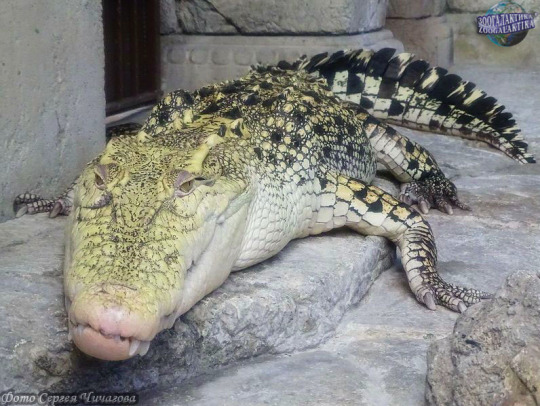
The longest-living species of crocodiles is the Siamese crocodile (Crocodylus siamensis), which can live up to 70 years in the wild and more than 100 years in captivity. The Siamese crocodile is a relatively small species of crocodile, reaching up to 3 meters in length, and inhabits freshwater bodies in Southeast Asia.
Other species of crocodiles that can also live up to 70 years in the wild and longer in captivity include the Gharial (Gavialis gangeticus) and the Saltwater crocodile (Crocodylus porosus), which inhabit India, Bangladesh, Australia, and other regions of Southeast Asia.
However, the lifespan of crocodiles can vary depending on the conditions of their habitat, food availability, and other factors, so there are individual differences in the longevity of different individuals.
In addition, the lifespan of crocodiles can depend on many factors such as food availability, climate, predation, and disease. Crocodiles grow and develop slowly, and this process can take several years, which can also affect their longevity. Crocodiles are an important part of the aquatic ecosystem, and their extinction can have serious consequences for biodiversity and ecosystem processes. Therefore, the conservation of crocodiles and their habitats is an important task for the preservation of the biological diversity of our planet.
Crocodiles belong to the reptile family and are close relatives of other reptiles such as alligators and caimans. They are predators and can feed on fish, amphibians, small mammals, and even other crocodiles. In addition to their role in ecosystems, crocodiles also play an important role in the culture and mythology of various peoples. They are a symbol of strength, endurance, and survival in difficult conditions.
0 notes
Text
Which animals have the strongest bite?#animals #strongest #bite
The saltwater crocodile (Crocodylus porosus) has the highest bite force of any animal alive today. (Image credit: DianaLynne via Getty Images)
Tyrannosaurus rex and megalodon are repeat science fiction stars for a reason: Their bites were ferocious. But which extinct and living creatures actually exert the strongest bite force?
Bite force, according to a study published in Frontiers (opens in…

View On WordPress
0 notes